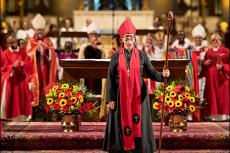The federal Bureau of Ocean Energy Management approved the South Fork Wind farm's Construction and Operations Plan on Wednesday, the final federal approval needed for the project's construction to commence.
Onshore construction of the 12-turbine, 132-megawatt installation, to be situated in federal waters approximately 35 miles east of Montauk Point, is to commence on or about Friday, Jan. 28, according to a notice of intent issued by its developers last week. The notice is a regulatory requirement of the developers, Orsted U.S. Offshore Wind and Eversource Energy. The regulatory filing requires setting a date of two weeks in the future, so construction will not start before the Jan. 28 target.
The Construction and Operations Plan approval outlines the project's one-nautical-mile turbine spacing, the requirements on the construction methodology for all work occurring in federal ocean waters, and mitigation measures to protect marine habitats and species.
BOEM's final approval of the plan follows the agency's November 2021 issuance of its Record of Decision, which concluded the BOEM-led environmental review of the project.
Onshore preconstruction activities for the wind farm began last Thursday with the collection of samples from previously installed groundwater monitoring wells and preparation of portions of the Long Island Rail Road right of way for construction. That initial work is taking place within the footprint of the transmission cable's onshore route.
Last year, following several years of discussion, debate, and public comment, the East Hampton Town Board and the town trustees approved easement and lease agreements allowing the wind farm's export cable to make landfall at the ocean beach in Wainscott and travel approximately 4.1 miles, below ground along town roads and the L.I.R.R. corridor, to a Long Island Power Authority substation in East Hampton, where it will connect to the electrical grid.
The New York State Public Service Commission issued a Certificate of Environmental Compatibility and Public Need in 2020, allowing the developers to construct and operate the export cable, which will be buried under the sea floor in approximately 3.5 miles of state waters.
In November, the commission approved an Environmental Management and Construction Plan for the export cable. That plan details the project's design and provides techniques, procedures, and requirements to be followed in the construction of the export cable.
Last week, the developers announced that Haugland Energy Group of Melville will install the underground duct bank system for the wind farm's onshore transmission line and lead the construction of the project's onshore interconnection facility in East Hampton. The agreement, they said, will create more than 100 union jobs for Long Island skilled trades workers, including heavy equipment operators, electricians, line workers, and delivery drivers who will transport materials to the project site.
Haugland Group affiliates are signatory to several Long Island unions, including the International Brotherhood of Electrical Workers Local 1049 and International Union of Operating Engineers Local 138, who will provide the labor for the project. In addition to Haugland Energy Group, several local businesses will support the construction and prioritize local sourcing of materials.
The project, which will be New York's first offshore wind farm, is to power approximately 70,000 average-size residences with wind energy when it begins operations at the end of 2023.
Because of a production error, an older version of this article appears in The Star's Jan. 20 print edition.



